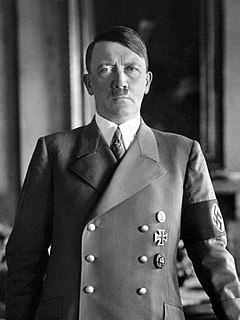
The Imperial German Navy was the navy created at the time of the formation of the German Empire. It existed between 1871 and 1919, growing out of the small Prussian Navy, which primarily had the mission of coastal defence. Kaiser Wilhelm II greatly expanded the navy, and enlarged its mission. The key leader was Admiral Alfred von Tirpitz, who greatly expanded the size and quality of the navy, while adopting the sea power theories of American strategist Alfred Thayer Mahan. The result was a naval arms race with Britain as the German navy grew to become one of the greatest maritime forces in the world, second only to the Royal Navy. The German surface navy proved ineffective during World War I; its only major engagement, the Battle of Jutland, was indecisive. However, the submarine fleet was greatly expanded and posed a major threat to the British supply system. The Imperial Navy's main ships were turned over to the Allies, but were sunk at Scapa Flow in 1919 by German crews.

The First Battle of Heligoland Bight was the first naval battle of the First World War, fought on 28 August 1914, between ships of the United Kingdom and Germany. The battle took place in the south-eastern North Sea, when the British attacked German patrols off the north-west German coast. The German High Seas Fleet was in harbour on the north German coast while the British Grand Fleet was out in the northern North Sea. Both sides engaged in long-distance sorties with cruisers and battlecruisers, with close reconnaissance of the area of sea near the German coast—the Heligoland Bight—by destroyer.

The Heligoland–Zanzibar Treaty was an agreement signed on 1 July 1890 between the German Empire and the United Kingdom. Under terms of this treaty, Germany gained the small but strategic Heligoland archipelago, which its new navy needed to control the new Kiel Canal and the approaches to Germany's North Sea ports. In exchange, Germany gave up its rights in the Zanzibar region in Africa, allowing Zanzibar to provide a key link in the British control of East Africa.
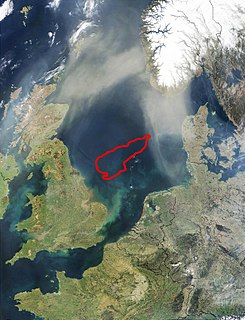
Dogger Bank is a large sandbank in a shallow area of the North Sea about 100 kilometres (62 mi) off the east coast of England.

The Heligoland Bight, also known as Helgoland Bight, is a bay which forms the southern part of the German Bight, itself a bay of the North Sea, located at the mouth of the Elbe river. The Heligoland Bight extends from the mouth of the River Elbe to the islands of Heligoland and lies between the East Frisian island of Wangerooge and the North Frisian peninsula of Eiderstedt.
Naval warfare in World War I was mainly characterized by the efforts of the Allied Powers, with their larger fleets and surrounding position, to blockade the Central Powers by sea, and the efforts of the Central Powers to break that blockade or to establish an effective blockade of the United Kingdom and France with submarines and commerce raiders.

SMS Cöln was a Kolberg-class light cruiser of the German Kaiserliche Marine during the First World War. She had three sister ships, SMS Kolberg, Mainz, and Augsburg. She was built by the Germaniawerft; her hull was laid down in 1908 and she was launched in June 1909. Cöln was commissioned into the High Seas Fleet in June 1911. She was armed with a main battery of twelve 10.5 cm SK L/45 guns and had a top speed of 25.5 kn. After her commissioning, she served with the II Scouting Group, part of the reconnaissance forces of the High Seas Fleet.
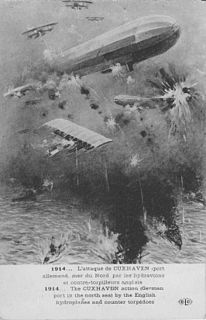
The Raid on Cuxhaven was a British ship-based air-raid on the German naval forces at Cuxhaven mounted on Christmas Day, 1914.
The North Sea, though often an area of conflict, has an extensive history of maritime commerce and trade routes between its coastal nations whose economies and industries were also able to exploit its resources. The earliest records of Roman explorations of the sea begin in 12 BC. Southern Britain was formally invaded in 43 AD and gradually assimilated into the Roman Empire, beginning sustained trade across the North Sea and the English Channel. The Germanic Angles, Saxons, and Jutes began the next great migration across the North Sea during the Migration Period, conquering, displacing, and mixing with the native Celtic populations. The Viking Age began in 793 and for the next two centuries the Vikings ruled the North Sea.

Hörnum (help·info) is a municipality in the district of Nordfriesland, in Schleswig-Holstein, Germany. It is located on the southern headland of the island of Sylt. The municipality is part of the Amt Landschaft Sylt. The economy is dominated by tourism.
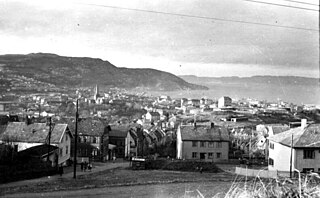
Nordstern, often erroneously referred to as Neu Drontheim, was the Nazi plan for the creation of a new German metropolis in German-occupied Norway during World War II. It was planned to have a population of around 250,000–300,000 inhabitants.
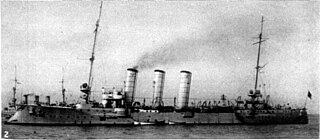
SMS Danzig was a light cruiser of the Imperial German Navy. Named for the city of Danzig, she was the seventh and last ship of the Bremen class. She was begun by the Imperial Dockyard in her namesake city in 1904, launched on 23 September 1905 and commissioned on 1 December 1907. Armed with a main battery of ten 10.5 cm (4.1 in) guns and two 45 cm (18 in) torpedo tubes, Danzig was capable of a top speed of 22 knots.

The High Seas Fleet (Hochseeflotte) was the battle fleet of the German Imperial Navy and saw action during the First World War. The formation was created in February 1907, when the Home Fleet (Heimatflotte) was renamed as the High Seas Fleet. Admiral Alfred von Tirpitz was the architect of the fleet; he envisioned a force powerful enough to challenge the Royal Navy's predominance. Kaiser Wilhelm II, the German Emperor, championed the fleet as the instrument by which he would seize overseas possessions and make Germany a global power. By concentrating a powerful battle fleet in the North Sea while the Royal Navy was required to disperse its forces around the British Empire, Tirpitz believed Germany could achieve a balance of force that could seriously damage British naval hegemony. This was the heart of Tirpitz's "Risk Theory," which held that Britain would not challenge Germany if the latter's fleet posed such a significant threat to its own.

Heligoland lighthouse is located on Germany's only offshore island, Heligoland. Constructed during World War II as an anti-aircraft tower, it was turned into a lighthouse in 1952. It features the strongest light on the German North Sea coast with a range of 28 nautical miles (52 km) so that it can be seen as far as on the East Frisian or the North Frisian islands and Halligen. The lighthouse is operated by the Tönning water and shipping authority.
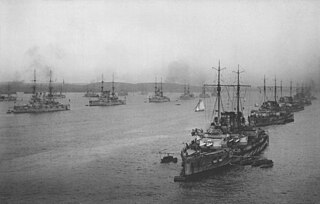
The II Battle Squadron was a unit of the German High Seas Fleet before and during World War I. The squadron saw action throughout the war, including the Battle of Jutland on 31 May – 1 June 1916, where it formed the rear of the German line.





